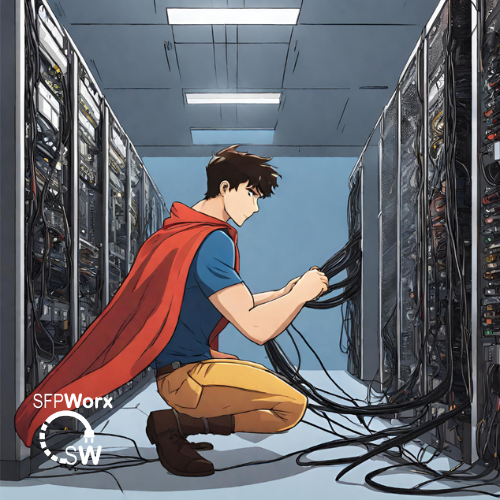With the threat of fibre bender and his ability to bend fibre cables still looming, Markus and his team remained vigilant. Markus and his team focused their efforts on the repair and restoration of optic transceivers. They knew that these devices were vital for the transmission of data through the fibre optic cables, and without them, the network would remain offline.
They started by assessing the damage to the fibre network. A large portion of the infrastructure had been destroyed in the disaster caused by fibre bender, Markus and his team quickly identified the most critical areas that needed immediate attention.
They worked tirelessly to replace the damaged optic transceivers, sourcing new ones from their secret high-quality manufacturers. In cases where the specific models were not available, they improvised and recoded existing transceivers that they had in their infinite stock hideout to ensure compatibility with the network.
Installation of the new transceivers was not a simple task. Each one had to be carefully inserted into the network equipment and meticulously connected to the fibre optic cables. Markus and his team took great care to follow strict procedures to avoid any further damage or connectivity issues.
Markus and his team conducted thorough testing to ensure the proper functioning of these optic transceivers before installation to ensure that the end user gets unmatched network quality. They performed comprehensive quality checks to guarantee that data could flow seamlessly through the repaired network.
Their efforts paid off, and slowly but surely, the city’s communication infrastructure started coming back online. Residents and businesses were once again able to access the internet, make phone calls, and transmit data without interruption.
But Markus and his team didn’t stop there. They recognised the importance of supplying high quality optics to prevent future network failures. So, they looked into ways of expanding bandwidth without having to replace the fibre cable infrastructure, which is how they discovered DWDM and CWDM.
Markus and his team worked closely with telecom providers and manufacturers to stay at the forefront of optic transceiver technology. They attended industry conferences and participated in research and development projects to continuously improve the performance and reliability of these vital components.
Their dedication to keeping the optic transceivers in top shape and their commitment to staying up-to-date with the latest advancements in the field earned them a reputation as experts in the industry. They became sought-after consultants, sharing their knowledge and experience with other organizations facing similar challenges.
Markus and his team knew that the optic transceivers were the lifeline of the city’s communication infrastructure, and they took their responsibility to maintain and repair them seriously. Their focused efforts not only restored connectivity to the city after the disaster but also ensured that the network remained stable and reliable in the long run.
As a result of their dedication, the city’s optic transceivers became known for their exceptional performance and durability. Telecommunication providers from neighboring cities sought their expertise in optimizing their own networks, and Markus and his team gladly shared their knowledge and best practices.
Through their efforts, Markus and his team created a lasting impact on the city’s communication infrastructure. Their focus on optic transceivers not only restored connectivity in the wake of the disaster but also laid the foundation for a robust and reliable network for years to come.




